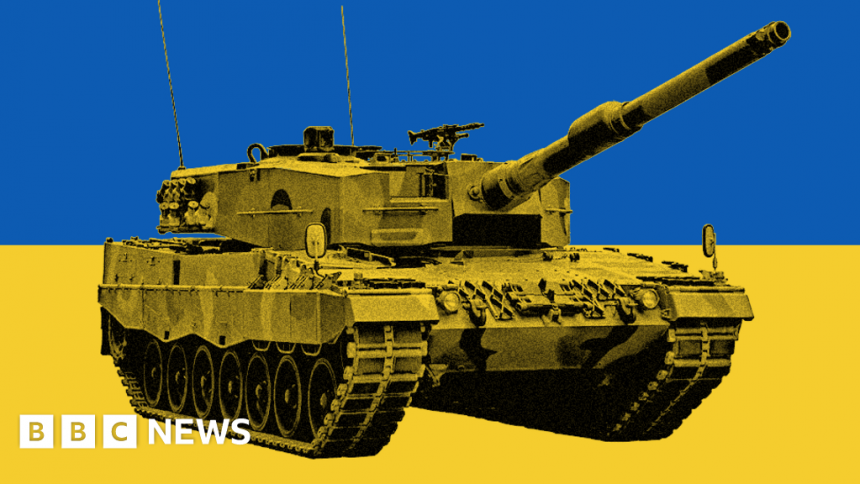Ukraine weapons: What arms are the UK and other countries supplying?
-
Published

The UK says it will supply Ukraine with 650 more short-range missiles, to boost its defences against Russia.
The US has also increased its military aid, with new supplies of longer-range missiles, anti-tank weapons and artillery shells.
What is the latest military aid for Ukraine?
The UK’s Ministry of Defence says it will send Lightweight Multirole Missiles to Ukraine, to help it counter missile and drone attacks. The first deliveries are expected by the end of 2024.
Ukraine’s President Volodymyr Zelensky has called for Western nations to supply more air defence systems following a series of Russian attacks on cities such as Poltava and Kharkiv.
The US government stepped up its supplies of arms to Ukraine after Congress approved a $61bn military aid package in April. Before that, its arms supplies had dried up for several months.
In the months before the US resumed its weapons supplies, Ukraine’s armed forces lost a lot of territory in the east of the country, largely because of a lack of artillery shells to check Russian advances.
Ukraine has also been putting into action F-16 fighter jets it received from the West in the summer.
Who has supplied the most military aid?
The US has been the biggest arms supplier to Ukraine.
Between February 2022 and the end of June 2024, it delivered or committed weapons and equipment worth $57bn (£43bn), according to the Kiel Institute for the World Economy,, external a German research organisation.
Germany gave Ukraine weapons and equipment worth $11.3bn (£8.6bn), the UK $9.8bn (£7.4bn), Denmark $7.1bn (£5.4bn), and the Netherlands $4.9bn (£3.7bn).
However, Germany is planning to halve its planned military aid to Ukraine in 2025, to about $4.4bn (£3.3bn).
What types of weapons have Western countries given Ukraine?
At the end of July, Ukraine’s President Zelensky said its air force had taken delivery of the first batch of F-16 fighter jets from the West. He said many more were needed.
Nato countries, including Belgium, Denmark, the Netherlands and Norway, have pledged to give Ukraine 65 or more of the US-made planes, which they had been planning to retire from their air forces.
In August 2023, the US gave permission for F-16s to be sent to Ukraine. Since then, Western nations have been training Ukrainian pilots to fly them.
Phillips O’Brien, Professor of Strategic Studies at St Andrews University says: “Ukraine will be using the F-16s mostly for defence against air attacks.”
The US-based Center for Strategic and International Studies says they could eventually be given extra roles, external, such as attacking Russian air defence systems, command centres and supply depots, and engaging Russian aircraft in Ukrainian airspace.
Air defence systems
To counter Russian drone and missile attacks on Ukraine’s cities and infrastructure, Western nations have sent it several types of air defence system.
These range from the UK’s short-range anti-aircraft weapon, Starstreak, to the Patriot missile system.
Patriots are expensive to operate – one missile costs about $3m.
The US and Norway have also provided the Nasams (National Advanced Surface-to-Air Missile System) for air defence, and Germany has offered the Iris-T.
Artillery and missiles
After Russia’s retreat from Kyiv in March 2022 – the month following its invasion – the war became focused on the east of the country. Since then, artillery and missiles have been heavily used by both sides.
Western countries have sent Ukraine over 620 artillery guns, including the US-made M777 howitzer, according to the Kiel Institute, external.
They have also given it 82 missile systems including Himars and the M270 multiple launch rocket system.
Ukraine has received long-range missiles such as Scalp from France and Storm Shadow from the UK.
The US has also supplied Ukraine with the longest-range version of ATACMS – a ballistic missile – which can travel 190 miles (300km). Before April 2024, it had only provided a shorter-range version.
In July 2023, the US said it had supplied cluster bombs to Ukraine to help dislodge Russian troops from defensive positions.
These weapons, delivered mostly in artillery shells, scatter multiple bomblets, and are banned by more than 100 countries because of the risk they pose to civilians.
Tanks
In early 2023, Western nations agreed to send tanks to Ukraine. It was hoped they would enable its forces to breach Russian defensive lines in a counter-offensive.
The UK provided 14 Challenger 2s.
European nations have sent 104 German-made Leopard 2 tanks, according to figures from the Kiel Institute, external.
The US sent 31 of its M1 Abrams tanks, which are thought to be the most advanced in the world.
However, none of this new armour enabled Ukraine to make a significant breakthrough in 2023.
Anti-tank weapons
Western countries first responded to Russia’s invasion in February 2022 by supplying Ukraine with defensive weapons to counter the enemy’s armoured brigades.
The US and UK supplied thousands of Javelin and Nlaw anti-tank missiles. These were considered crucial in stopping the advance of Russian forces on Kyiv.
Drones
Drones have been used extensively throughout the war, for surveillance, targeting, launching missiles and as “kamikaze” weapons.
Turkey supplied missile-firing Bayraktar TB2 drones at the start of the conflict, the US has provided “Switchblade” kamikaze drones, and several countries have sent commercial surveillance drones, such as the Chinese-made DJI Mavic 3.
In February 2024, the UK government said it would join a coalition of countries supplying Ukraine with thousands of “first person view” drones, external, for observation and target spotting.







